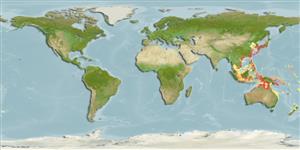Common names from other countries
>
Gobiiformes (Gobies) >
Gobiidae (Gobies) > Gobiinae
Etymology: Favonigobius: Latin, favonius = gentle, propicious and Latin, favonianus = the west wind; 1656 + Latin, gobius = gudgeon (Ref. 45335).
More on author: Bleeker.
Environment: milieu / climate zone / depth range / distribution range
Écologie
marin; eau douce; saumâtre récifal; amphidrome (Ref. 59012). Subtropical
Western Pacific: Japan, Korean Peninsula, and China (Ref. 559); also in southern Taiwan (Ref. 36073), Australia, Palau Is. (Ref. 37816), and Micronesia (Ref. 59012).
Taille / Poids / Âge
Maturity: Lm ? range ? - ? cm
Max length : 13.4 cm TL mâle / non sexé; (Ref. 121534)
Description synthétique
Clés d'identification | Morphologie | Morphométrie
Épines dorsales (Total) : 6 - 7; Rayons mous dorsaux (Total) : 9; Épines anales: 1; Rayons mous anaux: 9.
Facultative air-breathing in the genus (Ref. 126274); Adults inhabit shallow sandy inner reefs and estuaries (Ref. 37816).
Life cycle and mating behavior
Maturities | Reproduction | Spawnings | Egg(s) | Fecundities | Larves
Masuda, H., K. Amaoka, C. Araga, T. Uyeno and T. Yoshino, 1984. The fishes of the Japanese Archipelago. Vol. 1. Tokai University Press, Tokyo, Japan. 437 p. (text). (Ref. 559)
Statut dans la liste rouge de l'IUCN (Ref. 130435)
CITES (Ref. 128078)
Not Evaluated
Menace pour l'homme
Harmless
Utilisations par l'homme
Outils
Articles particuliers
Télécharger en XML
Sources Internet
Estimates based on models
Preferred temperature (Ref.
115969): 20.4 - 29, mean 28 (based on 706 cells).
Phylogenetic diversity index (Ref.
82804): PD
50 = 0.5020 [Uniqueness, from 0.5 = low to 2.0 = high].
Bayesian length-weight: a=0.00692 (0.00414 - 0.01157), b=2.99 (2.85 - 3.13), in cm Total Length, based on LWR estimates for this species & (Sub)family-body (Ref.
93245).
Niveau trophique (Ref.
69278): 2.7 ±0.14 se; based on food items.
Résilience (Ref.
120179): Haut, temps minimum de doublement de population inférieur à 15 mois (Preliminary K or Fecundity.).
Fishing Vulnerability (Ref.
59153): Low vulnerability (10 of 100).
